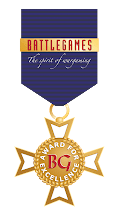 Dwarves in Tanks 6
Dwarves in Tanks 6The tank designer’s thought that ‘bigger is best’ and the later designs began to take on gigantic proportions.
DampfPanzerWagon VI (Hammer or Hammerer)
A fully enclosed single boilered landship built of iron plates but with a design and decoration that harks back to a former generation. The crew compartment is spacious and functional with a Dwarf Thunderer canon in the bow. The ‘Hammer’ is crewed by five dwarves (the largest crew of any of the operational DampfPanzerWagons).
The ‘Hammer’s’ size makes it slightly slower than other panzer models, although this is countered by the sheer size, power and presence of the vehicle on the battlefield. In addition the Dwarf hammer imagery is so powerful in the psyche of all dwarves, both friend and foe that the DPW VI is seen as a battle banner.
The huge drive wheels are able to propel this model forward over terrain that would see other DPW’s bogged down, while the elevated commanders tower is a boon to successful strategy.
Special Rules
1 ½ inch less move per turn due to the size.
2 Battle Banner - + 2 for all friendly troops within 12 inches and – 2 for all enemy troops attacked.
3 +1 leadership for the commander as he is so well sited in the tower.
Construction
Inspiration came from Games Workshop – both fantasy and 40,000K and the stern paddle steamers of the American West. I wanted a monster landship full of traditional dwarf imagery – crossed hammers, precious metals and dwarf-fortress sized. The main hull and wheel housings are from card and foam board covered with plastic card. The main structures were easy, it was the crossed hammers that took all the time and effort, plastic card over-lay, more plastic card and then modeling putty.
The main wheels were cut from a curry powder lid, the boiler was left from the boiler used in DPW III, the chimney from plastic tube and rings from a cheap biro, other detail from scrap and the spares box most notably from ‘Atlantis’ toys which give a gothic or ‘steam punk' feel to the finished design.
The imagery and colours are symbolic of the dwarf empires of an earlier time, Gold decoration over Prussian Blue. Ivory white chimneys representing the batons that the Napoleonic generals were given and strong dwarf emblems - the crossed hammers. The colour is Citadel Blue with lots of washes and Citadel gold over bronze.
The building in the background is a model of a Russian church that I first saw while on holiday in France and later in a folktale book. It is built from card over foamboard with 'Das' clay tiles. The model is painted as the folktale illustration and is one of the largest gaming pieces in my Flintloque collection.
Tony






No comments:
Post a Comment